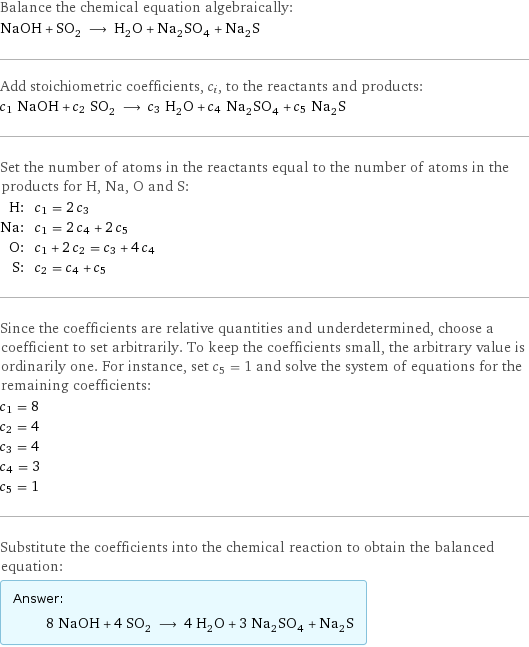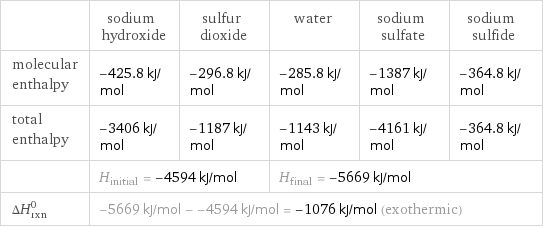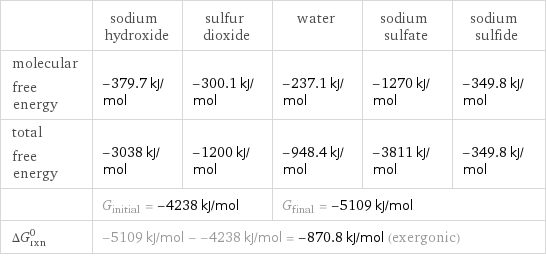Input interpretation

NaOH sodium hydroxide + SO_2 sulfur dioxide ⟶ H_2O water + Na_2SO_4 sodium sulfate + Na_2S sodium sulfide
Balanced equation

Balance the chemical equation algebraically: NaOH + SO_2 ⟶ H_2O + Na_2SO_4 + Na_2S Add stoichiometric coefficients, c_i, to the reactants and products: c_1 NaOH + c_2 SO_2 ⟶ c_3 H_2O + c_4 Na_2SO_4 + c_5 Na_2S Set the number of atoms in the reactants equal to the number of atoms in the products for H, Na, O and S: H: | c_1 = 2 c_3 Na: | c_1 = 2 c_4 + 2 c_5 O: | c_1 + 2 c_2 = c_3 + 4 c_4 S: | c_2 = c_4 + c_5 Since the coefficients are relative quantities and underdetermined, choose a coefficient to set arbitrarily. To keep the coefficients small, the arbitrary value is ordinarily one. For instance, set c_5 = 1 and solve the system of equations for the remaining coefficients: c_1 = 8 c_2 = 4 c_3 = 4 c_4 = 3 c_5 = 1 Substitute the coefficients into the chemical reaction to obtain the balanced equation: Answer: | | 8 NaOH + 4 SO_2 ⟶ 4 H_2O + 3 Na_2SO_4 + Na_2S
Structures

+ ⟶ + +
Names

sodium hydroxide + sulfur dioxide ⟶ water + sodium sulfate + sodium sulfide
Reaction thermodynamics
Enthalpy

| sodium hydroxide | sulfur dioxide | water | sodium sulfate | sodium sulfide molecular enthalpy | -425.8 kJ/mol | -296.8 kJ/mol | -285.8 kJ/mol | -1387 kJ/mol | -364.8 kJ/mol total enthalpy | -3406 kJ/mol | -1187 kJ/mol | -1143 kJ/mol | -4161 kJ/mol | -364.8 kJ/mol | H_initial = -4594 kJ/mol | | H_final = -5669 kJ/mol | | ΔH_rxn^0 | -5669 kJ/mol - -4594 kJ/mol = -1076 kJ/mol (exothermic) | | | |
Gibbs free energy

| sodium hydroxide | sulfur dioxide | water | sodium sulfate | sodium sulfide molecular free energy | -379.7 kJ/mol | -300.1 kJ/mol | -237.1 kJ/mol | -1270 kJ/mol | -349.8 kJ/mol total free energy | -3038 kJ/mol | -1200 kJ/mol | -948.4 kJ/mol | -3811 kJ/mol | -349.8 kJ/mol | G_initial = -4238 kJ/mol | | G_final = -5109 kJ/mol | | ΔG_rxn^0 | -5109 kJ/mol - -4238 kJ/mol = -870.8 kJ/mol (exergonic) | | | |
Equilibrium constant
![Construct the equilibrium constant, K, expression for: NaOH + SO_2 ⟶ H_2O + Na_2SO_4 + Na_2S Plan: • Balance the chemical equation. • Determine the stoichiometric numbers. • Assemble the activity expression for each chemical species. • Use the activity expressions to build the equilibrium constant expression. Write the balanced chemical equation: 8 NaOH + 4 SO_2 ⟶ 4 H_2O + 3 Na_2SO_4 + Na_2S Assign stoichiometric numbers, ν_i, using the stoichiometric coefficients, c_i, from the balanced chemical equation in the following manner: ν_i = -c_i for reactants and ν_i = c_i for products: chemical species | c_i | ν_i NaOH | 8 | -8 SO_2 | 4 | -4 H_2O | 4 | 4 Na_2SO_4 | 3 | 3 Na_2S | 1 | 1 Assemble the activity expressions accounting for the state of matter and ν_i: chemical species | c_i | ν_i | activity expression NaOH | 8 | -8 | ([NaOH])^(-8) SO_2 | 4 | -4 | ([SO2])^(-4) H_2O | 4 | 4 | ([H2O])^4 Na_2SO_4 | 3 | 3 | ([Na2SO4])^3 Na_2S | 1 | 1 | [Na2S] The equilibrium constant symbol in the concentration basis is: K_c Mulitply the activity expressions to arrive at the K_c expression: Answer: | | K_c = ([NaOH])^(-8) ([SO2])^(-4) ([H2O])^4 ([Na2SO4])^3 [Na2S] = (([H2O])^4 ([Na2SO4])^3 [Na2S])/(([NaOH])^8 ([SO2])^4)](../image_source/9be463d98811f66faa01370663a6c948.png)
Construct the equilibrium constant, K, expression for: NaOH + SO_2 ⟶ H_2O + Na_2SO_4 + Na_2S Plan: • Balance the chemical equation. • Determine the stoichiometric numbers. • Assemble the activity expression for each chemical species. • Use the activity expressions to build the equilibrium constant expression. Write the balanced chemical equation: 8 NaOH + 4 SO_2 ⟶ 4 H_2O + 3 Na_2SO_4 + Na_2S Assign stoichiometric numbers, ν_i, using the stoichiometric coefficients, c_i, from the balanced chemical equation in the following manner: ν_i = -c_i for reactants and ν_i = c_i for products: chemical species | c_i | ν_i NaOH | 8 | -8 SO_2 | 4 | -4 H_2O | 4 | 4 Na_2SO_4 | 3 | 3 Na_2S | 1 | 1 Assemble the activity expressions accounting for the state of matter and ν_i: chemical species | c_i | ν_i | activity expression NaOH | 8 | -8 | ([NaOH])^(-8) SO_2 | 4 | -4 | ([SO2])^(-4) H_2O | 4 | 4 | ([H2O])^4 Na_2SO_4 | 3 | 3 | ([Na2SO4])^3 Na_2S | 1 | 1 | [Na2S] The equilibrium constant symbol in the concentration basis is: K_c Mulitply the activity expressions to arrive at the K_c expression: Answer: | | K_c = ([NaOH])^(-8) ([SO2])^(-4) ([H2O])^4 ([Na2SO4])^3 [Na2S] = (([H2O])^4 ([Na2SO4])^3 [Na2S])/(([NaOH])^8 ([SO2])^4)
Rate of reaction
![Construct the rate of reaction expression for: NaOH + SO_2 ⟶ H_2O + Na_2SO_4 + Na_2S Plan: • Balance the chemical equation. • Determine the stoichiometric numbers. • Assemble the rate term for each chemical species. • Write the rate of reaction expression. Write the balanced chemical equation: 8 NaOH + 4 SO_2 ⟶ 4 H_2O + 3 Na_2SO_4 + Na_2S Assign stoichiometric numbers, ν_i, using the stoichiometric coefficients, c_i, from the balanced chemical equation in the following manner: ν_i = -c_i for reactants and ν_i = c_i for products: chemical species | c_i | ν_i NaOH | 8 | -8 SO_2 | 4 | -4 H_2O | 4 | 4 Na_2SO_4 | 3 | 3 Na_2S | 1 | 1 The rate term for each chemical species, B_i, is 1/ν_i(Δ[B_i])/(Δt) where [B_i] is the amount concentration and t is time: chemical species | c_i | ν_i | rate term NaOH | 8 | -8 | -1/8 (Δ[NaOH])/(Δt) SO_2 | 4 | -4 | -1/4 (Δ[SO2])/(Δt) H_2O | 4 | 4 | 1/4 (Δ[H2O])/(Δt) Na_2SO_4 | 3 | 3 | 1/3 (Δ[Na2SO4])/(Δt) Na_2S | 1 | 1 | (Δ[Na2S])/(Δt) (for infinitesimal rate of change, replace Δ with d) Set the rate terms equal to each other to arrive at the rate expression: Answer: | | rate = -1/8 (Δ[NaOH])/(Δt) = -1/4 (Δ[SO2])/(Δt) = 1/4 (Δ[H2O])/(Δt) = 1/3 (Δ[Na2SO4])/(Δt) = (Δ[Na2S])/(Δt) (assuming constant volume and no accumulation of intermediates or side products)](../image_source/d2a6aa35fcfd6732d243c42b3e988cb8.png)
Construct the rate of reaction expression for: NaOH + SO_2 ⟶ H_2O + Na_2SO_4 + Na_2S Plan: • Balance the chemical equation. • Determine the stoichiometric numbers. • Assemble the rate term for each chemical species. • Write the rate of reaction expression. Write the balanced chemical equation: 8 NaOH + 4 SO_2 ⟶ 4 H_2O + 3 Na_2SO_4 + Na_2S Assign stoichiometric numbers, ν_i, using the stoichiometric coefficients, c_i, from the balanced chemical equation in the following manner: ν_i = -c_i for reactants and ν_i = c_i for products: chemical species | c_i | ν_i NaOH | 8 | -8 SO_2 | 4 | -4 H_2O | 4 | 4 Na_2SO_4 | 3 | 3 Na_2S | 1 | 1 The rate term for each chemical species, B_i, is 1/ν_i(Δ[B_i])/(Δt) where [B_i] is the amount concentration and t is time: chemical species | c_i | ν_i | rate term NaOH | 8 | -8 | -1/8 (Δ[NaOH])/(Δt) SO_2 | 4 | -4 | -1/4 (Δ[SO2])/(Δt) H_2O | 4 | 4 | 1/4 (Δ[H2O])/(Δt) Na_2SO_4 | 3 | 3 | 1/3 (Δ[Na2SO4])/(Δt) Na_2S | 1 | 1 | (Δ[Na2S])/(Δt) (for infinitesimal rate of change, replace Δ with d) Set the rate terms equal to each other to arrive at the rate expression: Answer: | | rate = -1/8 (Δ[NaOH])/(Δt) = -1/4 (Δ[SO2])/(Δt) = 1/4 (Δ[H2O])/(Δt) = 1/3 (Δ[Na2SO4])/(Δt) = (Δ[Na2S])/(Δt) (assuming constant volume and no accumulation of intermediates or side products)
Chemical names and formulas

| sodium hydroxide | sulfur dioxide | water | sodium sulfate | sodium sulfide formula | NaOH | SO_2 | H_2O | Na_2SO_4 | Na_2S Hill formula | HNaO | O_2S | H_2O | Na_2O_4S | Na_2S_1 name | sodium hydroxide | sulfur dioxide | water | sodium sulfate | sodium sulfide IUPAC name | sodium hydroxide | sulfur dioxide | water | disodium sulfate |